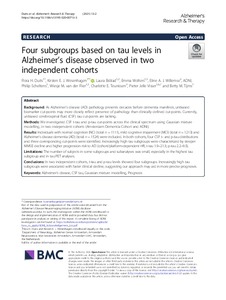Four subgroups based on tau levels in Alzheimer's disease observed in two independent cohorts
Duits Flora H; Wesenhagen Kirsten EJ; Ekblad Laura; Wolters Emma; Willemse Eline AJ; Scheltens Philip; van der Flier Wiesje M; Teunissen Charlotte E; Visser Ppieter Jelle; Tijms Betty M
Four subgroups based on tau levels in Alzheimer's disease observed in two independent cohorts
Duits Flora H
Wesenhagen Kirsten EJ
Ekblad Laura
Wolters Emma
Willemse Eline AJ
Scheltens Philip
van der Flier Wiesje M
Teunissen Charlotte E
Visser Ppieter Jelle
Tijms Betty M
BMC
Julkaisun pysyvä osoite on:
https://urn.fi/URN:NBN:fi-fe2021042823611
https://urn.fi/URN:NBN:fi-fe2021042823611
Tiivistelmä
BackgroundAs Alzheimer's disease (AD) pathology presents decades before dementia manifests, unbiased biomarker cut-points may more closely reflect presence of pathology than clinically defined cut-points. Currently, unbiased cerebrospinal fluid (CSF) tau cut-points are lacking.MethodsWe investigated CSF t-tau and p-tau cut-points across the clinical spectrum using Gaussian mixture modelling, in two independent cohorts (Amsterdam Dementia Cohort and ADNI).ResultsIndividuals with normal cognition (NC) (total n =1111), mild cognitive impairment (MCI) (total n =1213) and Alzheimer's disease dementia (AD) (total n =1524) were included. In both cohorts, four CSF t- and p-tau distributions and three corresponding cut-points were identified. Increasingly high tau subgroups were characterized by steeper MMSE decline and higher progression risk to AD (cohort/platform-dependent HR, t-tau 1.9-21.3; p-tau 2.2-9.5).LimitationsThe number of subjects in some subgroups and subanalyses was small, especially in the highest tau subgroup and in tau PET analyses.ConclusionsIn two independent cohorts, t-tau and p-tau levels showed four subgroups. Increasingly high tau subgroups were associated with faster clinical decline, suggesting our approach may aid in more precise prognoses.
Kokoelmat
- Rinnakkaistallenteet [27094]
